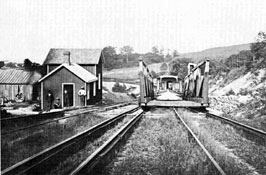Morris Canal was built to transport coal from the Lehigh Valley of Pennsylvania to industrial markets in Newark and New York. The total length of the canal was 106 miles. The canal climbed an astonishing 914 feet from Newark Bay to the summit at Lake Hopatcong, and then dropped 760 feet to the Delaware River at Phillipsburg. This gave the canal an average vertical slope of 18 feet per mile, steep compared to the contemporary Erie Canal's relatively gentle slope of one foot per mile.
A system of 23 hydraulically powered inclined planes - in combination with 23 locks, which were used for elevation changes of 12 feet or less - was used to accomplish these grade changes. The inclined planes were essentially short railways that could allow the canal boats to change as much as 100 feet in elevation in 15 minutes.
Resources
- Barbara N. Kalata, A Hundred Years, A Hundred Miles (Morristown, NJ: Morristown Historical Society, 1983).



